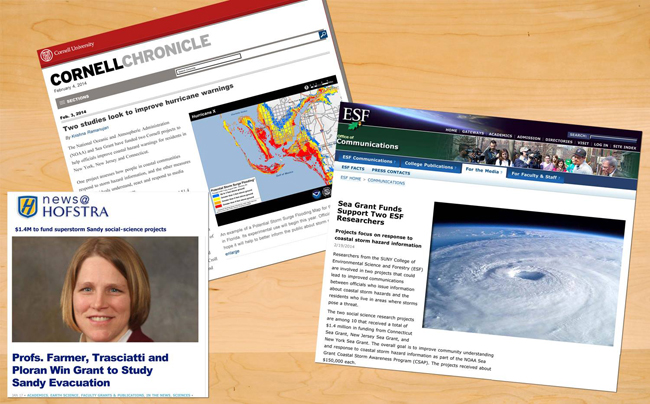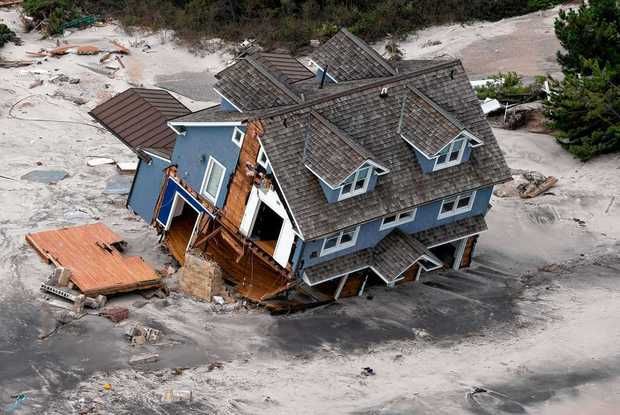
Since
being announced in mid-January, the research projects under the
National Oceanic and Atmospheric Administration (NOAA)'s $1.4M "Coastal
Storm Awareness Program" (CSAP) have been garnering attention from a
number of the universities with funded investigators. This multi-year
effort - a partnership between NOAA and Sea Grant programs in New York,
New Jersey and Connecticut - is intended to raise awareness of how severe weather is communicated to and within communities.
In February, both Cornell University's Cornell Chronicle and the State
University of New York's College of Environmental Science and Forestry
each highlighted several of the CSAP studies, which are all currently
underway. The feature stories are, respectively, "
Two Cornell studieslook to improve hurricane warnings" and "
Sea Grant Funds Support Two ESF Researchers."
And, in January, Hofstra, where another of the 10 projects is being
conducted, released the news item, "
Profs. Farmer, Trasciatti and Ploran Win Grant to Study Sandy Evacuation" (pdf).
Syracuse, NY, February 25, 2014 - When a big storm such as Superstorm Sandy is on its way, the authorities do everything they can to warn people along the coast about the urgency of evacuation.
However, in the case of Sandy and other storms, many residents don't heed the warnings.
Researchers from State University College of Environmental Science and Forestry (ESF) are joining other scientists in developing ways to improve communications between emergency officials and residents.
"When people fail to evacuate after storm warnings, their decision-making process is not always rational," said Sharon Moran, an ESF geographer and the principal investigator on the ESF-led project. "We want to understand what needs to be done to help them make better choices."
A special focus will be people with disabilities. Moran said more than half the people who died during Superstorm Sandy were elderly or disabled.
"There were reports of wheelchair ramps that were never unlocked, buses that never came, people in wheelchairs who had to go back to their homes," she said. "We need to understand more about the risks they faced."
Moran's team will consult key stakeholders, conduct focus groups, run surveys, analyze data and then build training modules and pilot them with coastal managers.
Moran and William Peace, an anthropologist with the Renee Crown Honors Program at Syracuse University, are working with Sam Ratick, of Clark University, and Rebecca Garden, of Upstate Medical University.
ESF's work is among projects sharing a $10.4 million grant as part of the NOAA Sea Grant Coastal Storm Awareness Program.
The college's work also includes a project developing hurricane forecasts using a new storm surge inundation map. The project is headed by Clifford W. Scherer, of Cornell University, with Laura N. Rickard of ESF.
The research team will help develop an experimental weather report to show focus groups. Participants will watch the report and indicate when they feel a hurricane risk might affect them. The goal is to better understand how New York, New Jersey and Connecticut coastal residents perceive hurricane-related and storm surge-related risk.
"The National Hurricane Center has made great strides in designing a new storm surge inundation map ... that visually displays the predicted amount of storm surge above ground at each specific location included in a hurricane track. Our research will complement this effort by testing how audiences perceive hurricane-related risk when this graphic is used in a live television broadcast," Rickard said.

A collapsed house is overwhelmed during Superstorm Sandy on the Jersey Shore coast. (AP Photo, 2012)
More Info: New York Sea Grant
New York Sea Grant (NYSG), a cooperative program of Cornell University
and the State University of New York, is one of 33 university-based
programs under the National Sea Grant College Program (NSGCP) of the
National Oceanic and Atmospheric Administration (NOAA). The NSGCP
engages this network of the nation’s top universities in conducting
scientific research, education, training and extension projects designed
to foster science-based decisions about the use and conservation of our
aquatic resources. Through its statewide network of integrated
services, NYSG has been promoting coastal vitality, environmental
sustainability, and citizen awareness about the State’s marine and Great
Lakes resources since 1971.
For updates on Sea Grant activities:
www.nyseagrant.org has RSS,
Facebook,
Twitter, and
YouTube links. NYSG also offers a free e-list sign up via
www.nyseagrant.org/coastlines for
NY Coastlines, its flagship publication, which, in 2014, merges with the program's e-newsletter,
Currents.
NY Coastlines is published several times a year.